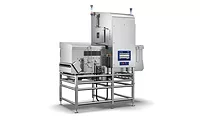Exposing Recent Improvements in X-Ray Inspection for Food Inspection
The tide has turned. With heavyweight big box grocery retailers now demanding that packaged food producers utilize X-ray for inspection of product, the switch to X-ray over metal detection for physical contamination has become more a question of when rather than if.
By now, most food producers recognize the advantages that X-ray inspection offers over aging technology like metal detectors and optical scanners. The list is extensive, but leads with the fact that X-ray equipment readily identifies stainless steel—the most common metal used in food processing equipment. Also, X-rays can spot nonmetallic objects such as bones, stones, glass and even sugar conglomerates. X-rays can even see through metalized packaging and work around other obstacles such as metal retaining clips without degrading the ability to find unwanted foreign objects.
All these advantages and the benefits they bring are undeniable. So why aren’t more food producers jumping on the X-ray bandwagon?
Cost no longer ranks as a major issue. Like so many other technologies, competition and improvements in manufacturing efficiency have dropped the price point of X-ray inspectors to within striking distance of high-end metal detectors. Even a spread of $20,000 to $30,000 pales in comparison to the potential loss of brand loyalty if just one foreign particle harms or alarms a consumer and its source gets traced back to the food producer.
Instead, feedback gathered over the years from major food producers points to two big issues that still give some of them pause before making the inevitable leap to X-ray: the perceived difficulty in operating these devices; and the feeling that factory technicians are required to maintain and repair them. In light of the newest X-ray inspection designs, a closer examination of these concerns reveals the fact that these fears are no longer founded.
Shortening the Operational Learning Curve
Traditionally, metal detectors have appealed to food producers because they are simple systems; hence they appear less complicated to repair. Also, metal detectors are easier to operate and adjust than traditional X-ray machines.
For instance, because X-ray machines currently used in the food inspection industry are unmanned, they require advanced image processing software to determine if a foreign object is present in the food or its packaging. As a result, they require highly trained personnel to adjust, setup, and maintain the image processing to get optimum performance.
However, any further extrapolation of these legacy assumptions stops at the point where the latest iterations of X-ray devices come in. With the introduction of new automatic training algorithms, these devices can now be setup quickly and easily.
For example, Novus X-Ray utilizes fully automatic training technology in their X-ray machines to learn what normal products should look like under the light of X-ray energy and reject anything else. This includes undesired contamination such as stainless steel, glass, and stone but can also be used to identify undesirable process variations.
A one-button “auto learning” system pioneered by Novus X-Ray allows a technician to visually inspect an X-ray image that has been falsely detected, and with one button tell the machine to ignore similar detections in the future. No further adjustments or even knowledge of how the image processing system works is required, making operation completely intuitive.
These advancements in image processing enable X-ray inspection to run almost on autopilot.
“I have other X-rays here, but the thing I like about the Novus units is their ability to self-train; a guy that doesn’t even know much about X-ray can do it,” says Bob Taylor, superintendent of electronics and controls at Clemens Food Group—a vertically coordinated company that includes hog farming, food production, logistical services and transportation. “Our ability to set them up is faster and a lot less frustrating, so it saves a lot of man hours,” Taylor adds.
Maintenance and Repair––Simplified
Food manufacturers have traditionally shied away from X-ray machines because of the belief that they are complicated, requiring factory-trained technicians for service and repair. In the past, the breakdowns justified the fear of extended production delays while a specialist had to be called in to repair the device. Hence, food manufactures have traditionally put up with the shortcomings of metal detectors for the simple reason that they were easier to fix.
That was then. Nowadays, the clever modularization of X-ray construction has made repairing these devices almost as easy as changing a light bulb.
By reason of example, Novus’ CCPX™ line of packaged food X-ray machines groups the various components of the system into just five modules: processing-detection, the human-machine-interface, input-output electronics, X-ray generator, and the cooling system.
To further speed the repair process, embedded software readily identifies which module needs replacement. The worker simply unplugs it from its cabling, unbolts that faulty module, inserts the replacement module, and reconnects the cabling. Any recalibration, mechanical alignment, or settings recovery takes place without worker intervention. Such ability makes repair and maintenance a matter of plug-and-play, lowering the knowledge and training bar to levels commonly found in plant maintenance personnel.
This modularization of X-ray inspection systems means that any necessary repairs can now take place quickly and easily. Access to replacement modules is available on a 24/7 basis from some vendors while most food production facilities go the extra step to purchase spare modules in advance for on-the-spot replacement. In the time it takes to change a bearing on a conveyor, for instance, the X-ray critical control point is back up and running again without even calling the factory for parts. The service model changes from factory technicians on-site to mail the defective module back for replacement.
“I have some guys who are specialists on the older X-ray units and they are very familiar with them; whereas I can send just about anybody out to a Novus unit to calibrate it,” says Taylor.
The newfound ease of operating and repairing today’s X-ray inspection devices means that a food producer can maintain these machines with their own existing personnel. Since no special training is required, employee turnover is no longer a problem to ensure that the machine operates at maximum uptime.
“We’re able to maintain the machines on our own, so it makes us very self-sufficient,” adds Taylor.
The Best of Both Worlds
Enabled by new technology, the simplification of operating and maintaining an X-ray inspection system allows packaged food producers to benefit from all the advantages that X-ray inspection offers, with the same ease and quick repair that legacy metal detection systems offered.
With the lower price differential and the very recent plug-and-play service model offered by some vendors, food producers still using metal detection have run out of excuses. Now that some of the largest food retailers are demanding X-ray inspection and competing food producers are adopting X-ray, the question of “when” to make the switch has been answered. The time is now.
Dave Rizzo is a California-based author. He's penned a number of articles, books and columns on topics ranging from technology and medicine to transportation.
Looking for quick answers on food safety topics?
Try Ask FSM, our new smart AI search tool.
Ask FSM →








